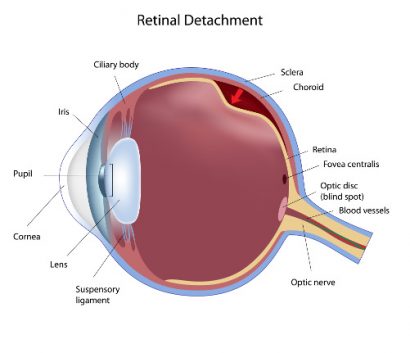Don’t Mess Around with Retinal Tears
Written by Dr. David Evans Last modified on August 14, 2018
We started Better Vision Guide to serve, not only as a one-stop consumer resource for information about the many treatments that can improve vision, but also to help educate about how to protect your eyes and prevent possible vision loss. In that vein, we published an article about retinal detachment along with a few real-world examples of retinal damage resulting in significant vision impairment. One of our articles describes the retinal damage for the Vikings Head Coach and how putting off treatment was a big mistake. A primary theme of these articles is how serious retinal damage is, how it can progress quickly, and why immediate examination and treatment are often warranted.
With that preamble in mind, let’s snap forward to a recent scare my wife experienced. We were driving back to San Diego from Los Angeles when my wife noticed flashing lights in one eye. We thought it could be a migraine and decided to see what happened in a few hours. The next morning she woke up with the same sensations and I immediately feared a retinal tear. We decided to practice what we preach and sought immediate examination and treatment.

Before I continue with the story, you might be wondering, what exactly is a retinal tear?
The retina is the layer of neural tissue that lays across the back of the eye and transforms visible images into signals that are transmitted to the brain for processing. In front of the retina is the vitreous, a gelatinous type of substance that is made mostly of collagen. The vitreous helps to hold the retina in place along the back of the eye. As our eyes age, the collagen can shrink or move, changes that can sometimes pull at the retina, tearing it.
The most common symptoms of a retinal tear are flashing lights in the periphery (similar to what my wife experienced). When a tear becomes too large or pronounced, it can lead to a full retinal detachment. While retinal tears do not typically degrade vision substantially, a detachment is a serious condition that can cause full, permanent loss of vision.
Retinal tearing is not always associated with natural, age-related changes to the vitreous. Retinal tears often occur due to trauma to the eye.
Now back to the story and the morning after…
Once we realized the issue was more than a migraine, I immediately went online to find a top retinal specialist that could see my wife first thing that morning. I also sent messages to a few of my ophthalmologist friends in San Diego to ask for a recommendation and a referral. We ended up finding an excellent practice very close to our home, and were at their doorstep when their offices opened at 8 am. The retinal surgeon was able to see us immediately. He dilated my wife’s eyes so he could examine the retina and locate the tear. I didn’t know this at the time, but sometimes retinal tears are so small, they are very hard to find. After examining for a few minutes, he was able to locate a minute tear in my wife’s peripheral vision. With the diagnosis confirmed, the next step was treatment.
Treatment for Retinal Tears
The most common treatment for a retinal tear is to use multiple laser pulses around the tear to “weld” the retina back together. The surgeon suggested that the tear was very small and that treatment could potentially wait, though he indicated that treatment would be needed at some time in the not too distant future. Not wanting to take a chance that the tear could enlarge and cause further problems, we opted to have the treatment done that day. The surgeon applied 60 to 70 laser pulses around the tear to stabilize and lock down the damaged area. It was a very quick, painless procedure that was completed in less than 5 minutes. With treatment completed, the next step was recovery.
Recovery after Retinal Tear
Immediately after treatment, my wife noted that the flashing lights had subsided, but had not completely disappeared. She also noticed some clouding of her vision. The retinal surgeon indicated that as the scars created by the laser pulses healed, the flashes would go away completely. He also said that the clouding of the vision was due to the vitreous being disturbed by the tear and the resulting laser pulses, and that her vision would clear in a matter of months. Indeed, he was correct on both counts. The flashes disappeared entirely in a matter of weeks and by November (the tear occurred in August), the cloudiness was virtually unnoticeable (although still present).
We feel very lucky to have recognized the issue and sought immediate treatment, and that we found a great retinal surgeon. I know we’re a bit of a broken record in our Better Vision Guide articles about being proactive about your visual health. But, that’s not going to stop me from saying it again. If you detect any problem with your vision — particularly an issue which indicates retinal damage — seek an examination immediately. Vision damage can progress quickly and in some cases, cannot be reversed.
